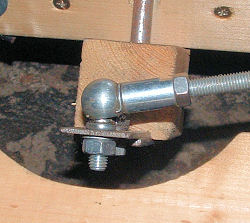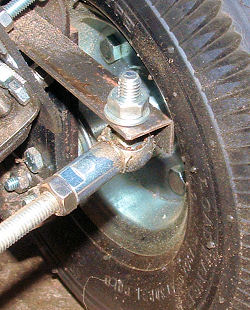 I
make regular use of small ball & socket joints in the
steering and suspension mechanisms of several of the
vehicles on the site. They are particularly useful for
joining steering actuation and track rods to front wheel
hub support assemblies where free rotation between the
joined components is needed about all three rotational
axes. I've also used them on panhard links in suspension
setups.
I
make regular use of small ball & socket joints in the
steering and suspension mechanisms of several of the
vehicles on the site. They are particularly useful for
joining steering actuation and track rods to front wheel
hub support assemblies where free rotation between the
joined components is needed about all three rotational
axes. I've also used them on panhard links in suspension
setups.
Small ball and socket joints are readily available and
fairly inexpensive. Both carbon steel and stainless
steel versions can be obtained with the stainless steel
joints being the more costly. Connecting thread sizes
between M5 and M16 are common with either right or left
handed threads available on the socket element of the
joint. Using opposite handed pairs on either end
of a connecting rod will allow fine length adjustment in situ
by rotating the connecting rod, however if very fine
adjustment is not needed and one joint can be
disconnected from the attached components for adjustment, same-handed joints can be
used on each end of the connecting rod - this
allows simple, inexpensive threaded bar to be used for the connected
rod.
 I
use the right-angled ball and socket joints mainly.
These generally have a higher push/pull load carrying
capacity than the in-line forms. For example
right-angled joints with M8 thread size and Ø13 mm ball
diameter have a max pull/push capacity of about 150kgf
which is adequate for most steering mechanism
applications I've designed.
I
use the right-angled ball and socket joints mainly.
These generally have a higher push/pull load carrying
capacity than the in-line forms. For example
right-angled joints with M8 thread size and Ø13 mm ball
diameter have a max pull/push capacity of about 150kgf
which is adequate for most steering mechanism
applications I've designed.
Attachment methods are fairly obvious - male threaded
stud on the ball element and a female threaded socket on
the socket element. Lock nuts should be used to lock the
socket element to the tie rod. One thing to note with
the right-angled forms is the limit of angular movement
which is roughly
±15° on the commonly available
units. This can represent a constraint in their
application and should be watched - forcing the joints
beyond their travel limits will induce bending moments
in the attached components and may cause the socket to
"pop" off the ball, so check for unrestricted travel on
assembly.